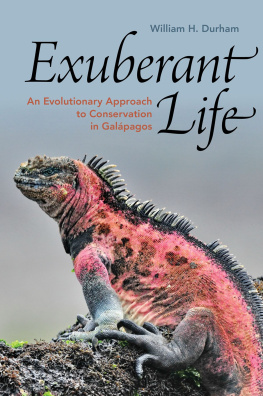Exuberant Life

Oxford University Press is a department of the University of Oxford. It furthers the Universitys objective of excellence in research, scholarship, and education by publishing worldwide. Oxford is a registered trade mark of Oxford University Press in the UK and certain other countries.
Published in the United States of America by Oxford University Press
198 Madison Avenue, New York, NY 10016, United States of America.
Oxford University Press 2021
All rights reserved. No part of this publication may be reproduced, stored in a retrieval system, or transmitted, in any form or by any means, without the prior permission in writing of Oxford University Press, or as expressly permitted by law, by license, or under terms agreed with the appropriate reproduction rights organization. Inquiries concerning reproduction outside the scope of the above should be sent to the Rights Department, Oxford University Press, at the address above.
You must not circulate this work in any other form and you must impose this same condition on any acquirer.
Library of Congress Control Number: 2020952645
ISBN 9780197531518
eISBN 9780197531532
DOI: 10.1093/oso/9780197531518.001.0001
To Ryan
celebrating your place in the tree of life
Contents
Chapter 1
Chapter 2
Chapter 3
Chapter 4
Chapter 5
Chapter 6
Chapter 7
Chapter 8
Chapter 9
Chapter 10
The natural history of this archipelago is very remarkable: it seems to be a little world within itself; the greater number of its inhabitants, both vegetable and animal, being found nowhere else.
Charles Darwin ( Narrative of the Surveying Voyages of His Majestys Ships Adventure and Beagle)
The book before you is a contemporary synthesis of what we know about the evolution of the curiously wonderful organisms of Galpagos, of how they are faring in the tumultuous world of human-induced change, and how evolution can guide our efforts today for their conservation. The book stems from the conviction that the more people know and appreciate the story Galpagos tells, with key subplots told by a diverse set of the archipelagos species, the better our chances of successfully managing the challenges facing the archipelago and ensuring its sustainable future.
The books impetus runs back to events earlier in my life. In 1975, while a graduate student, I wrote a proposal to the Smithsonian Tropical Research Institute to join their expedition to Galpagos. I proposed to study a potential mutual relationship between giant tortoises and their key food, the prickly pear cacti of the genus Opuntia.I wanted to ask whether tortoises, who readily consume the large, fleshy fruits of the cactus, thereby enhance its seed dispersal, building on the suggestion of ). The expedition was never reorganized, but still I dreamed of getting to Galpagos.
Meanwhile, educational tourism in Galpagos was flourishing, and the chance to visit finally came when Stanford Universitys Travel-Study Program invited me to lead a tour. Arriving at last, I found Galpagos even more fascinating than I had imagined. Happily, evidence today confirms my earlier curiosity: tortoises do enhance Opuntiaseed dispersal and, indeed, they do much more, as described in a sunflower to a whopping 6.5 ft (2 m)it took first place at the county fair. What a surprise, years later, to find in Galpagos a closely related speciesan endemic daisygrowing 10 times higher (to 65 ft or 20 m) in a genuine forestof daisies! With that I was convinced that something very special about Galpagos had shaped its flora and fauna in ways that seemed to break all records.
That trip taught me another key lesson about Galpagos. Because organisms adapted to this little world within itself, per Darwin above, free of terrestrial predators or competitors, they live their lives fully in the open with their many wonderful details on display. Todays visitors can have a field day using principles of evolution and ecology to make sense of it all. For example, the wonderful adaptations of plants and animals to the islands consistently illustrate the principle of reproductive advantage. No matter how curious the adaptationsflightlessness, seaweed-eating, giant proportions, and more all of themhave some net survival and reproduction advantage to individual bearers in their Galpagos environment.














